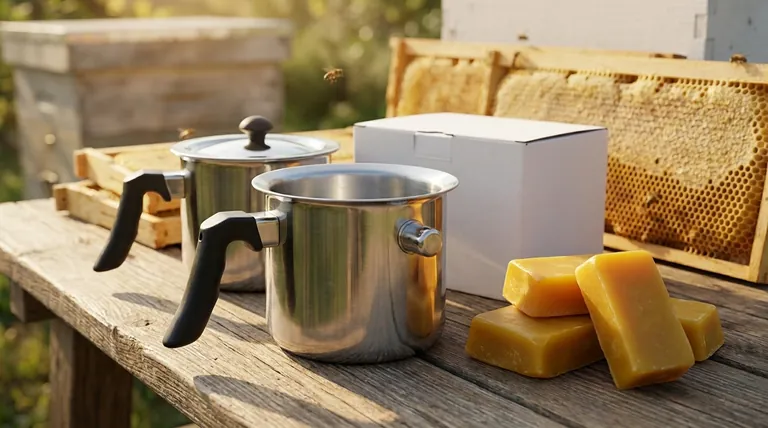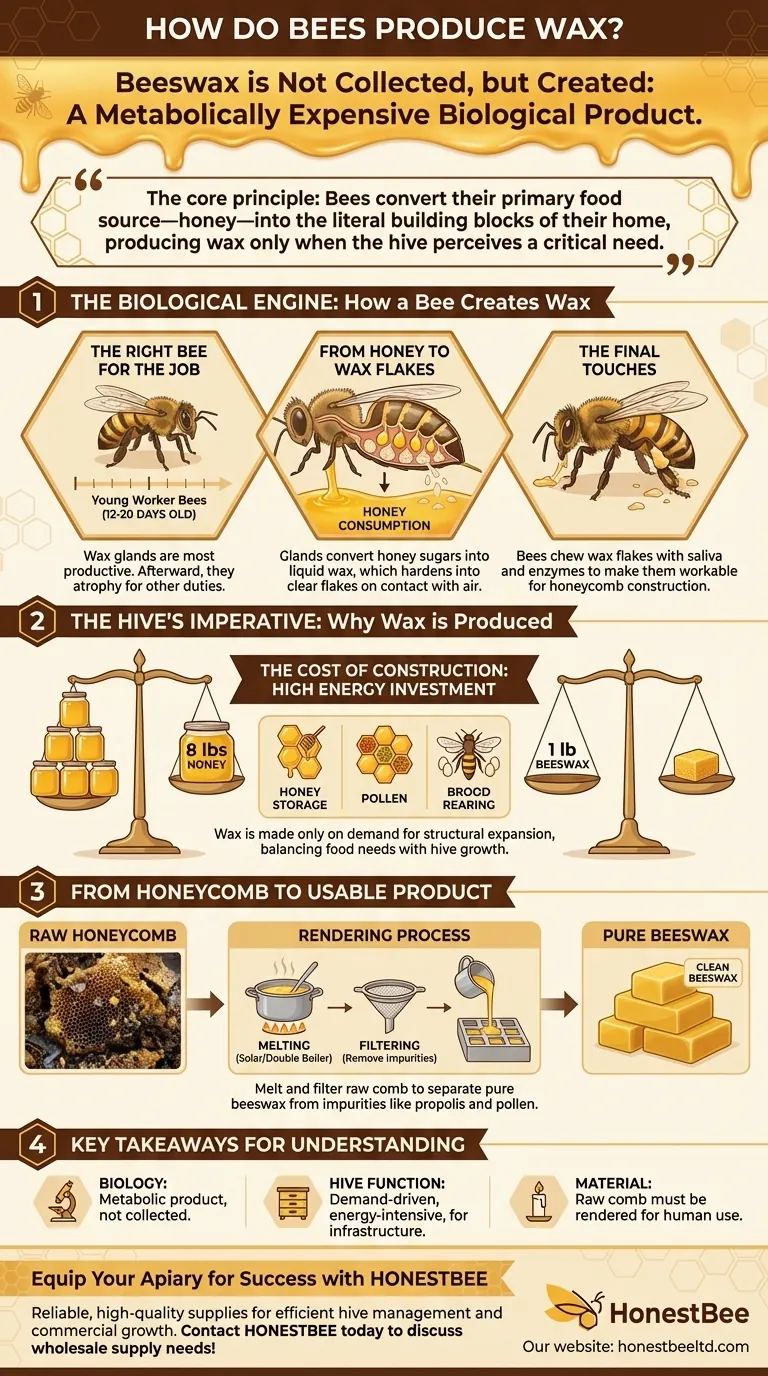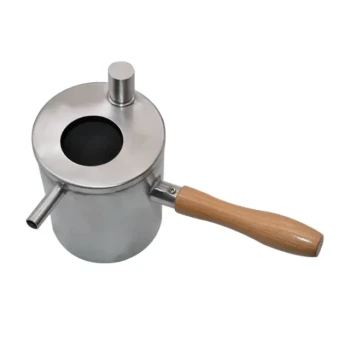Beeswax is not collected, but created. It is a biological product manufactured by specific bees for a specific purpose. Young worker bees, typically between 12 and 20 days old, consume large amounts of honey and metabolize its sugars, which special glands on their abdomens then convert into wax. This wax is secreted as small, clear flakes, which the bees then chew and manipulate to build the intricate structure of their honeycomb.
The core principle to understand is that beeswax is a metabolically expensive product. Bees must convert their primary food source—honey—into the literal building blocks of their home, producing it only when the hive perceives a critical need for new construction.

The Biological Engine: How a Bee Creates Wax
The Right Bee for the Job
The task of wax production falls to young worker bees. Their wax glands are most productive when they are between 12 and 20 days old.
After this period, the glands begin to atrophy, and the bee moves on to other hive duties like foraging.
From Honey to Wax Flakes
To produce wax, a bee gorges on honey. The sugars are processed by eight specialized wax glands located on the underside of the bee's abdomen.
This metabolic process converts the sugar into liquid wax, which seeps through tiny pores in the bee's exoskeleton. Upon contact with the air, this liquid hardens into small, transparent flakes.
The Final Touches: Chewing and Building
The bee uses the stiff hairs on its hind legs to scrape these delicate wax flakes from its abdomen.
It then passes the flakes forward to its mandibles (jaws). The bee chews the wax, mixing it with saliva and enzymes, which makes the brittle flake pliable, workable, and ready for construction.
The Hive's Imperative: Why Wax is Produced
A Response to Need
Wax production is not a constant activity. Worker bees only begin making wax when the colony requires it for a specific purpose.
This is most common when the hive needs to build new comb for storing honey and pollen or to create cells for the queen to lay eggs and raise brood.
The Cost of Construction
Creating wax is incredibly energy-intensive. Bees must consume an estimated eight pounds of honey to produce just one pound of beeswax.
This high cost means the colony must carefully balance its need for structural expansion against its immediate food requirements.
From Honeycomb to Usable Product
The Role of Rendering
The wax that forms the honeycomb is not pure. It contains residual honey, pollen, propolis, and other debris from the hive.
For human use, this raw comb must be rendered. Rendering is simply the process of melting and filtering the raw comb to separate the pure beeswax from impurities.
Key Steps in Rendering
The process is straightforward. First, the raw comb is gently melted, often using a solar melter or a double boiler to prevent scorching.
Next, the molten liquid is strained through a filter, like cheesecloth, to remove solid debris. Finally, the clean, liquid wax is poured into molds and allowed to cool and harden.
Key Takeaways for Your Understanding
Understanding how bees produce wax allows you to appreciate it from several different perspectives.
- If your primary focus is biology: The key is that wax is a metabolic product secreted from abdominal glands, not a collected substance.
- If your primary focus is the hive's function: Wax production is a demand-driven, energy-intensive task performed by young bees to build essential infrastructure.
- If your primary focus is the material itself: Raw honeycomb must be rendered—melted and filtered—to become the clean beeswax used in products.
Ultimately, this process reveals beeswax not just as a material, but as a remarkable feat of biological engineering and social cooperation.
Summary Table:
| Stage | Key Actor | Key Action | Key Outcome |
|---|---|---|---|
| Production | Young Worker Bees (12-20 days old) | Metabolize honey via abdominal glands | Secretion of clear wax flakes |
| Construction | Worker Bees | Chew and manipulate wax flakes with saliva | Creation of pliable wax for honeycomb |
| Purpose | The Hive | Demand-driven response to need | New comb for honey, pollen, and brood |
| For Human Use | Beekeeper | Rendering (melting & filtering raw comb) | Pure, clean beeswax for products |
Equip Your Apiary for Success with HONESTBEE
Understanding the intricate process of wax production highlights the importance of a healthy, productive hive. For commercial apiaries and beekeeping equipment distributors, having reliable, high-quality supplies is non-negotiable for maximizing honey and wax yields.
HONESTBEE supports your operation's growth by providing:
- Essential Beekeeping Supplies: From hive components to protective gear, everything you need for efficient hive management.
- Wholesale-Focused Operations: Competitive pricing and bulk options tailored for commercial-scale beekeeping.
Let us help you build a stronger foundation for your bees' remarkable work. Contact HONESTBEE today to discuss your wholesale supply needs!
Visual Guide

Related Products
- Beeswax Melter for Candle Making Honey Bee Wax Melter
- Steam Beeswax Melter Wax Warmer for Wax Processing
- Professional Stainless Steel Wax Melter for Beekeeping and Crafts
- Honey Wax Separating Wax Press with Metal Screw Wax Separator Machine
- Electric Beeswax Flat Sheet Machine with Operating Tray for Wax Processing
People Also Ask
- What are the benefits of using a professional wax melter? Achieve Consistent, Scalable, and Safe Production
- What are the main types of wax melters? Choose the Right Heating Method for Your Needs
- What do you use a wax melter for? From Home Fragrance to Professional Beekeeping
- How do water jacket melters function? Achieve Gentle, Scorch-Free Melting for Sensitive Materials
- What is the flashpoint of beeswax? Essential Safety and Quality Tips for Beekeepers



















